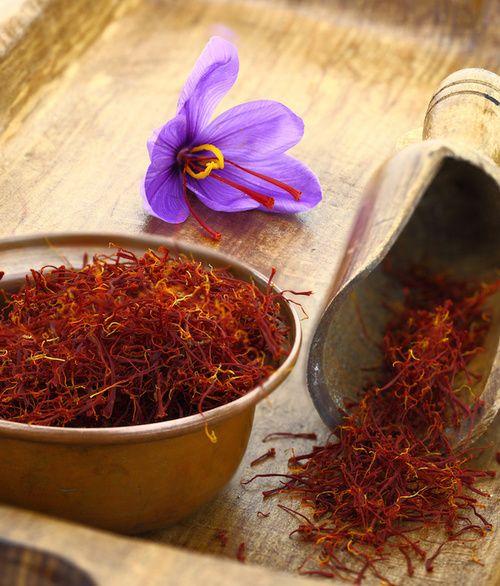Lo saffron is a spice rich in carotenoids and vitamins, useful for i mood disturbances, as a sedative and antispasmodic. Let's find out better.
> Properties and benefits of saffron
> Calories and nutritional values of saffron

Description of the plant
The spice called saffron is derived from the stigmas of the flower of Crocus sativus, belonging to the Iridaceae family. Perennial herbaceous plant, which can reach a height of 30 cm., Is born spontaneous in Asia Minor and in 'Eastern Europe, but it is also successfully cultivated in el country, where there are extensive crops in the Marchein Abruzzo and Sardinia.
Other noteworthy growing areas are found in Umbria and Tuscany. In general, the plant prefers warm and well-ventilated hilly areas that do not undergo large changes in temperature during the year; love the sun, therefore, it has difficulty in growing if it is cultivated in humid and foggy areas; on the other hand, it does not fear frost.
La root, it is a spherical bulb-tuber, fleshy and white inside, while externally it is covered with reddish-brown membranes. The leaves they are numerous, thin, linear, similar to blades of grass, and gray-green in color. The delicate ones fiori funnel-shaped, of a purplish lilac color, appear in autumn and for the flowering to be generous, the summer climate must have been hot.
Each flower opens to the rays of the sun and tightens up when it is dark or raining; inside its corolla it has three stigmas (female reproductive organs) of color bright red, from which the spice is obtained.
Properties and benefits of saffron
The stigmas of saffron contain beyond 150 volatile aromatic substances, components of its essential oil. It is also one of the richest foods carotenoids (crocetin, α-crocin, picrocrocin and safranal) which give the typical yellow-gold color to the dishes, e vitamin A, B1 (thiamine) e B2 (riboflavin).
In particular the saffron, is an organic compound, able to positively influence brain activity. For this reason it is used in phytotherapy in the treatment of mood disturbances, as sedative e antispasmodic with anthelmintic activity, effective against motion sickness. Indeed, its active ingredients by regulating the production of some neurotransmitters brain responsible for mood (such as dopamine, noradrenaline and serotonin), are able to calm anxiety.
In addition to making the most diverse dishes tasty and flavourful, the saffron powder it is a mine of precious substances for the body: saffron being one of the most powerful antioxidants, counteracts free radicals, responsible for the acceleration of cellular aging. Plus this spice fenhances digestive functions, stimulates the digestive system, increasing the secretion of bile and gastric juices. For this reason it is also widely used in the preparation of digestive liqueurs.
Furthermore, in recent times, saffron is proving to be a very effective natural remedy for many ailments related to modern lifestyle such as stress, depression. In fact, recent studies have shown that saffron has properties and benefits on the part of the nervous system which regulates the sensory receptors of the movement of muscles and joints, thus exercising acalming action, analgesic e antispasmodic, which induces a state of muscle relaxation.
Calories and nutritional values of saffron
100 g of saffron contain 310 kcal, e:
- 11,43 g protein
- G carbohydrates 65,37
- 5,85 g fat
- Dietary fiber 3,9 g
- Sodium 148 mg
Saffron, an effective travel companion against car sickness

Use in the kitchen
The use of the saffron in the kitchen, on the other hand, it ranges from appetizers to desserts, but the best combinations are with rice, shellfish, seafood, stewed meats and delicate sauces. In these cases, the taste of saffron enriches, colors and enhances the flavors.
Usually this spice it must be added at the end of cookingotherwise it loses its flavor and scent. Particular attention should also be paid to the dosage: for three / four people a sachet of 0,15 grams is sufficient.
In some cases (in stewed dishes, for example) it is possible to add it right from the start of cooking, but diluting it in water.
Curiosities about saffron
The name Crocus comes from the Greek Kroke, what does it mean "filament", for the filamentous stigmas that it carries at the center of the corolla. It is mentioned in the Ebers papyrus, in the Song of Songs and in the Iliad, and over the centuries it has been attributed curative properties against insomnia, plague, impotence and frigidity In fact, historically saffron has always had the reputation of aphrodisiac and this peculiarity is remembered by the Greek myth of Crocus. According to the myth these filaments symbolize a love bond between the ninfa Smilax and young Krokos, a love destined to end with the death of the young man. It is said that the gods, pitying, transformed the nymph in sarsaparilla and young man in crocus, to ensure that the two could live side by side. For this myth the ancient Greeks used to place a crocus flower on the tombs of lovers who died out of love.
Pliny and Dioscorides also attributed to this spice the ability to restore sexual energy e force to men and increase the desire in women. Today it was confirmed that saffron stimulates hormone productioni that tone the sexual sphere, while antioxidants improve circulation.
La collection of flowers is carried out in autunno, in the morning at sunrise, before the chalice opens and the stigmas (that is, the feminine elements of the flower) that carry the precious dust can be ruined. Once the flowers have been collected, you must proceed to touch, that is to the separation of the stigmas from the corollas. The stigmas then go immediately dried, then placed in hermetically sealed containers that must be kept in dry place.
This spice is often prone to sophistication, in fact, to obtain a kilo of saffron about 100.000 stigmas of flowers must be collected and this makes the product very valuable. Safflower, also known as saffron, is sometimes passed off as saffron safferanone or bastard saffron, which however has coloring rather than aromatic qualities.


























